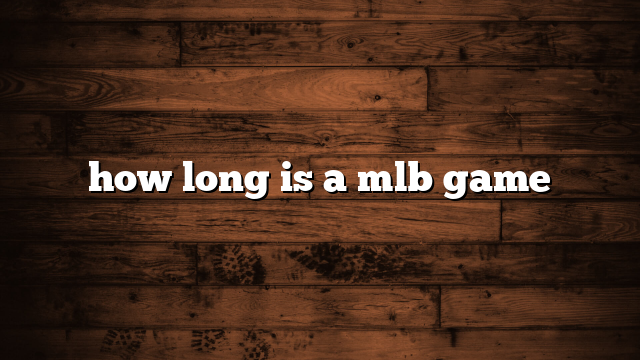How Long is a MLB Game?
Major League Baseball (MLB) has a rich history and a dedicated fan base that spans generations. One of the most common questions among new and seasoned fans is, “How long is an MLB game?” Understanding the duration of a game, including the factors that influence its length, can enhance your appreciation and enjoyment of this timeless sport. In this comprehensive guide, we will explore the typical length of an MLB game and the various elements that contribute to its duration.
Standard Duration of an MLB Game
A standard MLB game consists of nine innings, with each inning divided into two halves: the top (when the visiting team bats) and the bottom (when the home team bats). Unlike many other sports that have a fixed time duration, baseball games are determined by the completion of these innings rather than by a clock.
Key Points:
- Innings: Nine innings
- Halves per Inning: Two halves (top and bottom)
- No fixed time: The game continues until all nine innings are completed (or more in case of a tie)
Average Length of an MLB Game
On average, an MLB game lasts about three hours. However, this duration can vary significantly based on several factors such as the pace of play, number of pitching changes, and scoring.
Average Duration:
- MLB Games: Approximately 3 hours
Factors Influencing the Length of an MLB Game
Several factors can influence the length of an MLB game, making each game unique in its duration.
- Pitching Changes: Frequent pitching changes, especially in the later innings, can add to the game’s length as managers switch pitchers to gain strategic advantages.
- Scoring: Games with high scores and many hits naturally take longer due to increased batting and pitching changes.
- Extra Innings: If the score is tied at the end of nine innings, the game continues into extra innings until a winner is determined.
- Game Pace: The pace at which pitchers and batters perform can either speed up or slow down the game.
- Replay Reviews: Video replay reviews for contested calls can add additional time.
- Weather Delays: Rain delays or other weather-related interruptions can extend the overall game duration.
Extra Innings: When Nine Aren’t Enough
When a game is tied at the end of the ninth inning, extra innings are played to determine the winner. Each team gets an additional chance to score in each extra inning, with the game continuing until one team has a lead at the end of an inning.
Extra Innings Breakdown:
- Continuation of Regular Play: Same structure as the first nine innings
- Variable Duration: Can significantly extend the length of the game
Speeding Up the Game: Recent Rule Changes
To address concerns about long game durations, MLB has implemented several rule changes aimed at speeding up the game. These include:
- Pitch Clock: Limits the time pitchers can take between pitches.
- Batter’s Box Rule: Requires batters to remain in the box between pitches.
- Limiting Mound Visits: Reduces the number of times coaches and players can visit the pitcher’s mound.
- Three-Batter Minimum: Requires pitchers to face at least three batters unless the inning ends.
Typical Game Flow and Breakdowns
Understanding the typical flow of an MLB game can help fans anticipate the length and enjoy the game more fully.
Pre-Game:
- Warm-Ups and National Anthem: Typically 30 minutes before the game starts.
During the Game:
- First Half-Inning: The visiting team bats.
- Second Half-Inning: The home team bats.
- Inning Breaks: Short breaks between each half-inning for commercials and player adjustments.
Post-Game:
- Post-Game Analysis and Interviews: Often 30 minutes to an hour on television broadcasts.
Comparisons with Other Levels of Play
The level of play can significantly impact the length of a baseball game. Here’s a look at how different leagues compare:
- Minor League Baseball: Generally faster-paced with fewer pitching changes, averaging slightly less than MLB games.
- College Baseball: Usually shorter than professional games, ranging from 2 to 3 hours.
- High School Baseball: Typically the shortest, often completed in 2 hours or less.
Watching MLB Games on TV: The Full Experience
For those watching MLB games on television, the broadcast typically includes pre-game shows, the game itself, and post-game analysis, extending the viewing experience to around 4 hours or more.
TV Broadcast Components:
- Pre-Game Show: 30 minutes to 1 hour
- Game Duration: Approximately 3 hours
- Post-Game Analysis: 30 minutes to 1 hour
Conclusion
In conclusion, the duration of an MLB game averages around three hours but can vary based on several factors including pitching changes, scoring, extra innings, and replay reviews. Recent rule changes have been introduced to speed up the pace of play and reduce game lengths. Understanding these elements can enhance your appreciation of the sport, whether you’re attending a game in person or watching on television.
By being aware of the factors that contribute to the length of an MLB game, fans can better plan their time and fully immerse themselves in the excitement of baseball. So next time you settle in to watch an MLB game, you’ll know what to expect and can enjoy every thrilling moment of America’s favorite pastime!
